North Iceland 2022
Sept 20
Before we could start our driving we made a bakery stop for breakfast, when we left we
grabbed some of the local donuts for the road. Kleina are traditional Icelandic donuts,
and recipes go back as far as the 14th century. Kleina (if you buy more than one
it's kleinur) are everywhere in Iceland. The baker recommended Kleina covered in
chocolate, cause they were her favourite.
SHE WAS RIGHT!


I know you have been wondering, but where are all the waterfalls, I miss the waterfalls... today we would make up for that. Rjúkandafoss was the first of our stops today, just a short walk from the main road.




Then it was a bit of driving to get to the next main destination.




Surprisingly there is a ton of these one lane bridges throughout Eastern and Northern Iceland, apparently it's way cheaper to replace a one lane bridge when they get washed out.


The second waterfall of the day is Dettifoss, it's a bit of a hike to get there over a rocky trail, but well worth it.
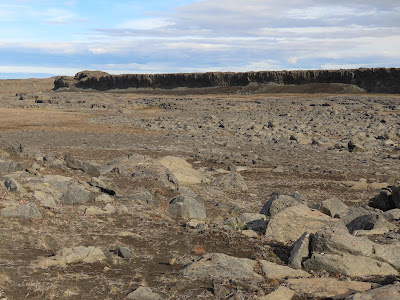


Dettifoss is fed by the glacier river Jökulsá á Fjöllum which flows from the largest glacier in Europe, Vatnajökull. It is supposed to be the second most powerful waterfall in Europe after the Rhine Falls in Switzerland.

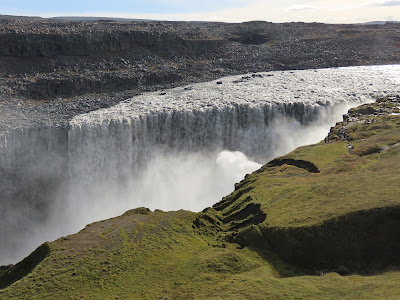







A little bit of a hike up the river takes you to Selfoss, not nearly as tall as Dettifoss, but much wider in a horseshoe shape.


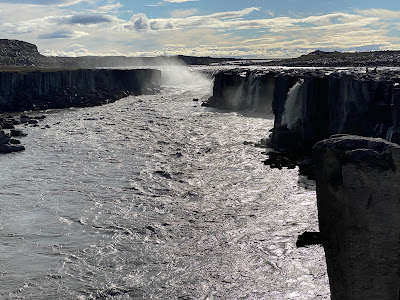



A quick stop at the "visitors centre", and we would be on our way.

Just outside of Mývatn is Námajfjall (aka Hverir), a geothermal area full of boiling pools and mudpits, as well as sulphur venting fumaroles creating a rather unpleasant egg smelling place to stop and wander. In 1969 a geothermal power plant was built west of the Námafjall Area. The plant currently produces 3MW of geothermal energy.





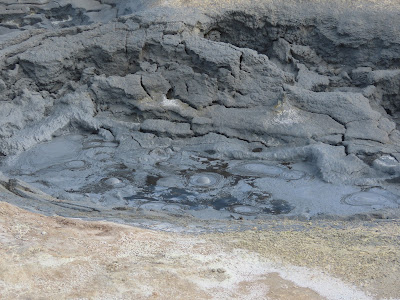







Mývatn
We drove into the incredibly small main town of Mývatn, got some groceries, and some really good fish & chips from one of the few restaurants that are open. I say restaurant, but it's a take-out window, so we had a picnic table lunch.


Our accommodations for the next few nights were at Birkilauf nature lodge, it's a guys house with 4 rooms out in the forest about 5 minutes from town. You drive down a dirt road and wind in to his location past a few wandering sheep. One of the nice benefits of the lodge, was free use of the washing machine, which we definitely needed.






The views from the nature lodge
After a busy day of hiking around waterfalls, we grabbed our clean bathing suits and headed to the nearby Jarðböðin Mývatn nature baths. It's much like the Blue Lagoon, but a little cheaper, a little wilder, and a little more scummy. By that, I mean there is a layer of scum from the sulphur or silica, or whatever is in the water, on any walls or seats around the lagoon. Suits will need washing again.






Today would have been our old friend Charlie Hughes birthday, it was also the day they were holding a celebration of life for him back home, so I had a beer and Norine had a wine in Charlie's honour. I think he would have appreciated that we swam up to a bar to get those drinks. Here's to you Charlie, may you rest in peace.




We met a nice couple from Indiana, turns out they were doing the same route as us, just in a shorter period. So we compared our travels and stops, damn them seeing the northern lights when we didn't.
It was getting late when we left the water, so we had a dinner of boxed food at the nature baths cafe, it didn't even have a tippy table.
Thoroughly relaxed and exhausted we got back to our room and went to sleep to the sound of rain.
Sept 21
The rain must have stopped during the night, cause we woke up to a very nice day. A good Icelandic day to circle Mývatn lake and check out the local sights.
Our first stop of the morning is the historically significant Grjótagjá, this is the cave where Jon Snow and Ygritte broke the rules in Game of Thrones. Nestled in a fracture is this natural hot spring inside a cave, due to volcanic activity fairly close to the surface, the water temperatures are very unpredictable and it is highly recommended not to swim here.











From the TV series Game of Thrones
Also in the Lake Mývatn area is the lava fortress of Dimmuborgir; this dramatic area was used to reflect the wildling camp of Mance Raider throughout Seasons Two and Three of Game of Thrones. We will go there later today.
Our next hike is visible from our lodge, Hverfjall, a crater that erupted approximately 4500 years ago.


It's a long steep continuous path to the rim, and it gets more and more windy the higher you go.





Somehow we expected to see more inside the crater when we reached the rim, but the views over lake Mývatn were pretty spectacular.


On our way again, we made a brief stop by Vogafjós Farm Resort to make a reservation for dinner later.





As mentioned earlier, our next stop was the Lava Fortress of Dimmuborgir. The lava field of Dimmuborgir, meaning black castle, is an amazing landscape that was created over 2,000 years ago. The contorted lava formations are made up of volcanic pillars, columns and arches, some extending as high as 20 meters. Paths lead through the black rock walls that tower above, past arches, caves and natural tunnels towards Kirkjan, a cave that resembles the doorway of a Gothic Church.



















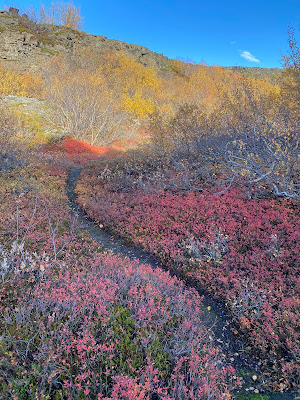


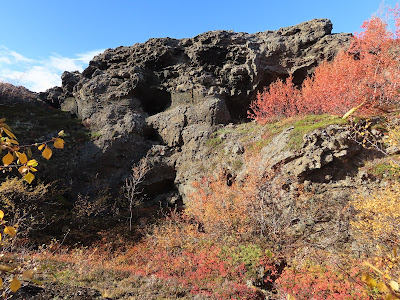




It is said that the Icelandic Yuletide Lads live in the mountains and caves around Dimmuborgir. They are the 13 sons of Grýla and Leppalúði, vicious trolls that live in a big cave. Every Christmas the dreadful ogress Grýla and her 13 sons come down from the mountains; Grýla in search of naughty children to boil in her cauldron and the boys in search of mischief. Grýla may only capture children who misbehave but those who repent must be released. During the 13 days preceding Christmas, Icelandic children place a shoe in their bedroom window. Each night one Yuletide Lad visits leaving sweets and small gifts or rotting potatoes, depending on how the child behaved the day before. During these visits the Yuletide lads are also known to steal and cause mischief.


Hidden around the area is the evidence that the yuletide Lads are nearby.






Just across the road from Dimmuborgir is the main lake, so we spent a bit of time walking the lakeside trails.










The Skútustaðagígar pseudo-craters are located on the South end of Lake Mývatn. The craters themselves are not magma-producing volcanic vents but were formed by gas explosions when boiling lava flowed over the cool, wet surfaces about 2,300 years ago.



It's about a one hour loop trail to circle around the craters, complete with views of the lake, sheep and horses.




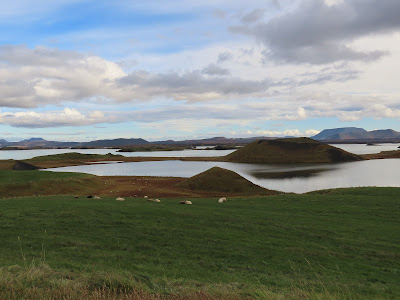







We crossed the road and bought ice cream right beside the cow farm, probably can't get fresher ice cream anywhere.


I know you have all probably been wondering, but what about waterfalls? I came here to see waterfalls! Well, our next stop was Goðafoss... translating to waterfall of the gods.




Having been disappointed by the lack of anything in the first volcano we climbed, we wanted to end the day with a better view and chose the Viti Crater. The name Viti means’ hell’, in reference to the violence in the past. Víti was formed in 1724 by a massive eruption that lasted for five years, and was called the Mývatn Fires. Jets of lava shooting in the sky were said to have been visible from the South Coast. Now the reward for climbing to the rim is a crystal blue lake.









Just below the crater is another small pool filled from the local Geothermal energy plant. But the oddest sight as you leave the area is this shower head on the side of the road. It continually pours out a nice warm shower, and is said to be very popular with the Volkswagen Vanagon Hippy crowd. Stories abound of naked hippies showering on the side of the road. We didn't see any, just a couple Canadians with wet arms.


Our lodge host recommended a little souvenir store run by a local lady who only brings in items she made or from local artists. We interrupted her knitting and bought a volcanic rock candle holder. A unique souvenir representative of what we saw today.


We decided to leave our car at the lodge and walked 30 minutes for dinner at Vogafjós Farm Resort







The meal was amazing; Lamb filet, and Arctic char. It started with geysir bread (rye),
baked in the ground from the day before. It was so good, and Norine somehow convinced them
to sell her a half loaf to take home with us.
Also, this Snorri beer was excellent, I looked for it on menus for the rest of our trip.




We walked back to our place in the dark with headlamps on, cause we knew it would be pitch black. As we are walking I shine my light over to the side and see 6 sets of eyes staring at us... sheep! Sure am glad there is no predators in Iceland.
Sept 22
It was an early start to the day as we packed up and head due North to Husavik for a whale watching trip.





Foggy rainy morning. The boat is full and we head out on our 3 hour tour... a 3 hour tour. The weather started getting rough, our tiny ship was tossed, along with half of the tourists cookies. We did see a pair of Northern bottle-nosed whales, from a long distance away, and that was it.




The back of the ship looked like that Pie Eating contest scene from Stand By Me. As part of the tour, the crew offered everyone a Hot Chocolate and a Cinnamon bun, and we would have loved it, but we had to go past all the people leaning over the back of the boat to get it, and that wasn't going to happen.

Back on dry/wet land we had a nice lunch at the historic GAMLI BAUKUR. Old Baukur was originally built in 1843 as a residence for the district magistrate, Sigfus Schulesen. Between 1884 and 1904 a popular restaurant was housed in Old Baukur. Fish & Chips were definitely on the menu, served in the old style... on a tippy table.
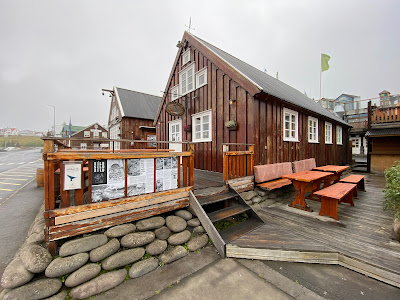

From Husavik we had to head back down to get around the Eyjafjörður (fjord) and then start driving up Tröllaskagi peninsula. It's a beautiful mountainous scenic drive with so many tunnels.The tunnels are very crudely carved out of the rock, a lot of them being only one lane with pullouts if there is oncoming traffic. There was a couple that were over 3 kilometers long, and one that was over 7 kilometers. The first of the tunnels is toll tunnel, that you have to pay online within 24 hours, it saves a 9 mile detour through high mountains that are often closed in the winter, so well worth the fee.








Siglufjörður
Siglufjörður is Iceland’s northernmost town and is a historic fishing town whose fame and fortune has always been linked to the ebb and flow of the fishing industry. A tiny shark fishing village in 1900, Siglufjörður soon became one of the largest towns in Northern Iceland and the undisputed capital of herring fishing in the Atlantic. The town has grown in popularity recently due to the series “Trapped”, filmed by Netflix. The first series was filmed in Seyðisfjörður, but the second and third series were made in Siglufjörður. The action of the film (2 seasons) also takes place in Siglufjörður and its immediate vicinity.




Our accommodation for the night was this incredibly cute cabin in the back of the Herring House in Siglufjörður. Nestled in the hillside, it gave us great privacy, our own hot tub and an outdoor shower. Our host was amazing, and she had the cutest little pup. Turns out the hot tub was empty, and she just asked we let her know if we wanted to use it, well yeah! "It will be ready to go by 8:00". Apparently it is geothermal, and filled up with hot water from the start.







For dinner we had sandwiches made with Norine's Geysir bread purchase, and worked with the host to make some plans for the next day. We had a lovely night with a Geothermal hot tub and outdoor shower under a light sprinkling of rain. We were able to ignore the fact we were behind a church with bells, and next door to a graveyard, and had the best night of sleep the whole trip.
Sept 23
Sadly we had to leave our little cabin behind and start heading West. As we are driving away our host comes out the front door of main house to make sure we enjoyed our stay, enjoyed the hot tub, and wished us safe journeys. Herring House is definitely getting top ratings in our reviews.


